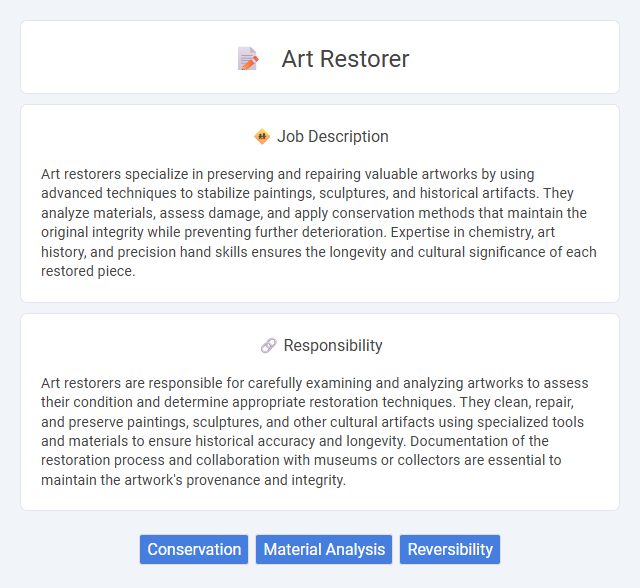
Art restorers specialize in preserving and repairing valuable artworks by using advanced techniques to stabilize paintings, sculptures, and historical artifacts. They analyze materials, assess damage, and apply conservation methods that maintain the original integrity while preventing further deterioration. Expertise in chemistry, art history, and precision hand skills ensures the longevity and cultural significance of each restored piece.
Individuals with strong attention to detail and patience are likely well-suited for an art restorer job, as the role requires meticulous work on delicate and valuable pieces. Those prone to frustration or lacking fine motor skills might find the demands of this profession challenging. The job may be more appropriate for people who enjoy combining creativity with scientific techniques and have a passion for art conservation.
Qualification
An art restorer must possess a strong background in fine arts, chemistry, and art history to accurately assess and preserve artworks. Qualifications typically include a bachelor's or master's degree in art conservation, restoration, or a related field, combined with hands-on experience in laboratory techniques and material science. Expertise in identifying pigments, varnishes, and historical art materials ensures effective and authentic restoration of paintings, sculptures, and cultural artifacts.
Responsibility
Art restorers are responsible for carefully examining and analyzing artworks to assess their condition and determine appropriate restoration techniques. They clean, repair, and preserve paintings, sculptures, and other cultural artifacts using specialized tools and materials to ensure historical accuracy and longevity. Documentation of the restoration process and collaboration with museums or collectors are essential to maintain the artwork's provenance and integrity.
Benefit
Art restorers likely experience the benefit of preserving cultural heritage, which may provide a strong sense of fulfillment and purpose. The role probably offers opportunities for specialized skill development and mastery in various restoration techniques. There is a chance that this profession can also lead to collaborations with museums and galleries, enhancing professional networks and career prospects.
Challenge
Art restorers likely face the challenge of balancing authenticity with preservation, requiring meticulous skill to avoid damaging fragile works. The probability of encountering unexpected material deterioration or previous restoration errors can complicate the conservation process. Precise decision-making is often crucial to maintain the artwork's original integrity while ensuring its longevity.
Career Advancement
Art restorers can advance their careers by gaining specialized certifications in conservation techniques and expanding expertise in various materials like oil paintings, sculptures, and textiles. Success in high-profile restoration projects and published research can lead to prestigious positions in museums or private conservation firms. Building a strong professional network and continuous education through workshops or advanced degrees enhances opportunities for leadership roles and consulting.
Key Terms
Conservation
Art restorers specializing in conservation meticulously analyze and treat artworks to prevent deterioration and extend their lifespan using advanced techniques and materials. Their expertise in stabilizing original pigments, repairing structural damages, and controlling environmental factors ensures the preservation of cultural heritage. Conservation efforts prioritize maintaining the artwork's authenticity while applying reversible and minimally invasive methods.
Material Analysis
Art restorers specialize in material analysis to identify the composition and condition of artworks, using techniques such as infrared spectroscopy, X-ray fluorescence, and microscopy. This scientific approach allows for precise diagnosis of degradation processes and informed decisions on appropriate conservation methods. Expertise in material characterization ensures the preservation of cultural heritage while maintaining the artwork's authenticity and longevity.
Reversibility
Art restorers prioritize reversibility to ensure all conservation treatments can be undone without damaging the original artwork, preserving its integrity for future restorers. Employing reversible materials and techniques allows for adjustments as new restoration methods evolve, maintaining the piece's authenticity. This approach supports sustainable preservation, enabling ongoing care and scholarly research on historical art objects.
 kuljobs.com
kuljobs.com